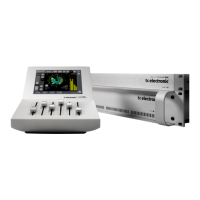104
bACkDrOP
MultiBand Model
The MultiBand model offers an enhanced set of controls
compared to the Basic model. The MultiBand model
provides three independent noise reduction engines split
across three frequency bands. Therefore you can apply
as much or as little noise reduction as is needed in each
of the three frequency bands. Of course, the cross-over
frequenciesforthethreebandsareentirelyadjustable
providing unprecedented flexibility in how the noise
reduction is applied.
The MultiBand model is a good choice for higher levels
of noise and when you need a high degree of precision in
where you apply the noise reduction. The MultiBand model
provides the same four primary controls (Aggression, Max
Reduction, Basilar Dispersion, and Transient Recovery) in
each of the three frequency bands.
The Aggression, Max Reduction, Basilar Dispersion,
Transient Recovery, and Link controls function exactly
as in the Basic Model, except they are split into three
bands.
MultiType Model
The MultiType model offers a unique and exciting new
approach to noise reduction. The MultiType algorithm is
based on the realization that most noises are actually
a sum of several different individual noise components.
Moreover, the noise components may not be equally
annoying and so it is sensible to apply more noise
reduction to the components which are most annoying.
Forexample,considerarecordingthathasbeencorrupted
by a combination of a hum due to a ground loop, room
rumble and tape hiss. In such a situation one often finds
that the tonal components of the hum are more annoying
than the other two noise components. Therefore, it
would be very useful to apply the most noise reduction
specifically to the hum component. Conversely, the tape
hiss component might be quite acceptable and so you
might want to leave it untouched while reducing the room
rumble component. Other noise reduction algorithms
operate on the composite noise signal and treat each noise
componentequally.WithBackDrop’sMultiTypealgorithm
Link
TheLinkbuttonlinksorgangsthecontrolssothatthey
operate on both the left and right channels together. When
notlinked,separatecontrolsareavailablefortheLeftand
Rightchannels.WhenenablingLinkmode,settingsforthe
Right channel will be copied to the Left channel. A pop-up
displaywillaskyoutoconfirmthisoperation.Itshould
be noted that the noise reduction processing remains
inde-pendent for each channel even if the controls are
linked.
Bypass
AsBypassinBackDropisusedmainlyasanA/Bcompare
functiontheBackDropbypassismadetoworkas
described here:
• Bypasswillalwaysdisablenoisereductionbutmaintain
the gain and M/S settings so only the noise changes.
• True24-bittransparencyisachievedduringbypassas
long as the Input Level Trims are 0.0dB and Processing
mode is Stereo.
LatencyintheBackDropalgorithmispreserved
in Bypass mode for optimal compare function.The
latency/processingdelayfortheBackDropalgorithm
isapproximately56msfromdigitalIntodigitalOut.

